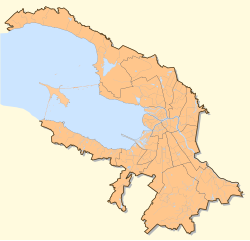Krasnoye Selo
| city
Krasnoye Selo
Красное Село
|
||||||||||||||||||||||||||||||||||||||||
|
||||||||||||||||||||||||||||||||||||||||
|
||||||||||||||||||||||||||||||||||||||||
| List of cities in Russia | ||||||||||||||||||||||||||||||||||||||||
Krasnoje Selo ( Russian Кра́сное Село́ ) is a city belonging to Saint Petersburg ( Russia ). It has 44,323 inhabitants (as of October 14, 2010).
geography
The city is located in the Ischora Heights about 25 km southwest of the city center of Saint Petersburg on the Dudergofka river , which flows into the Gulf of Finland in the Baltic Sea near the Urizk district of Saint Petersburg .
Krasnoye Selo is the center of the eponymous raion of the city with federal subject status Saint Petersburg.
history
The village of Krasnoye Selo (Russian for beautiful village ; krasnoye in its old meaning) was established at the beginning of the 18th century.
From 1765 this was the location of the guard troops of the Saint Petersburg garrison of the Imperial Russian Army . A paper factory was also built. Because of its picturesque, hilly location, the area was a popular area for country houses in the wealthy districts of the Russian capital.
The place played a special role in the development of Russian aviation: in 1882 Alexander Moshaiski carried out his - albeit unsuccessful - experiments with a steam engine-powered airplane here; before the First World War there was an airfield here. B. Igor Sikorski successfully tested his Russki Witjas , the world's first four-engine airplane.
During the Russian Civil War near Krasnoye Selo in late autumn 1919, the troops of the white general Nikolai Yudenitsch advancing on Petrograd were stopped and smashed.
The conferment of town charter was already under discussion in October 1918 and was finally carried out in 1925, as was also the case for Urizk located further north (until 1918 Ligowo , today a settlement or municipal district (Okrug) of the Krasnoye Selo district).
During the Second World War , Krasnoye Selo was occupied by the German Wehrmacht during the Leningrad blockade . On January 19, 1944, it was recaptured by the Red Army as part of the Leningrad-Novgorod operation .
In 1973 the city of Krasnoye Selo was assigned to the newly founded Stadtrajon of the then Leningrad.
In the meantime, the official name of the city from 1996 was Municipal District (Okrug) No. 43 , but from 1999 it was again the city of Krasnoye Selo .
Population development
| year | Residents |
|---|---|
| 1897 | 3,000 |
| 1939 | 12,654 |
| 1959 | 16,286 |
| 1970 | 27.208 |
| 2002 | 44,081 |
| 2010 | 44,323 |
Note: Census data (1897 rounded)
Culture and sights
The bridge building department of the Saint Petersburg Central Railway Museum is located in Krasnoye Selo .
Economy and Infrastructure
The city is located on the Saint Petersburg ( Baltic Railway Station ) - Gatchina railway line . The route to Krasnoye Selo was opened in 1859. The continuation to Gatchina, a good 20 kilometers away, took place in 1872, where the connection to the line to Tallinn, which was opened continuously in 1870 , was made. Previously, the trains ran to Gatchina on the route towards Warsaw .
The A180 St. Petersburg – Ivangorod road (border with Estonia ) runs through Krasnoye Selo .
Sons and daughters
- Nikolai Gorbunow (1892–1938), politician
- Nikolai Piljugin (1908–1982), space engineer
- Pawel Morschtschinin (1933–2009), cross-country skier
Individual evidence
- ↑ a b Itogi Vserossijskoj perepisi naselenija 2010 goda. Tom 1. Čislennostʹ i razmeščenie naselenija (Results of the All-Russian Census 2010. Volume 1. Number and distribution of the population). Tables 5 , pp. 12-209; 11 , pp. 312–979 (download from the website of the Federal Service for State Statistics of the Russian Federation)
Web links
- City administration website (Russian)
- History of Krasnoye Selo (Russian website)




